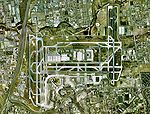Toronto Area Control Centre
Toronto Area Control Center (ICAO: CZYZ) is one of seven area control centers in Canada operated by Nav Canada. The Toronto Area Control Centre is based near Toronto Pearson International Airport in Mississauga, Ontario. From the Toronto Area Control Centre, air traffic controllers provide en route and terminal control services to aircraft in the Toronto Flight Information Region (FIR). The Toronto FIR airspace covers most of Southern Ontario, Central Ontario, parts of Eastern Ontario, and parts of northwestern Michigan. To the east are the air traffic control centres of Montreal and Boston; to the south are the Minneapolis, Cleveland (which covers the extreme southwestern area of Ontario), and New York air traffic control centres; to the west is the Winnipeg control centre.
Excerpt from the Wikipedia article Toronto Area Control Centre (License: CC BY-SA 3.0, Authors).Toronto Area Control Centre
Midfield Road, Mississauga
Geographical coordinates (GPS) Address Nearby Places Show on map
Geographical coordinates (GPS)
| Latitude | Longitude |
|---|---|
| N 43.671596833333 ° | E -79.627360833333 ° |
Address
ACC
Midfield Road
L4W 2P7 Mississauga
Ontario, Canada
Open on Google Maps








